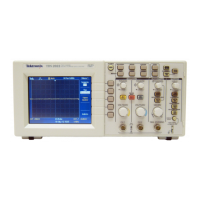USB Flash Drive and Device Ports
To remove a USB fl
ash drive, wait until the LED on the drive (if any) stops
blinking or until the h int line appears that says the operation is complete, grab the
edge of the drive, and extract the drive from the port.
Flash Drive Initial Read
Time
The oscilloscope reads the internal structure of a USB flash drive each time you
install a drive. The time to complete the read depends on the size of the flash
drive, how the drive is formatted, and the number of files stored on the drive.
NOTE. To significantly shorten the initial read time of 64 MB and larger USB
flash drives, format the drive on your PC.
Formatting a Flash Drive
The Format function deletes all data on the USB flash drive. To format a flash
drive, follow these steps:
1. Insert a USB flash drive into the Flash Drive port on the front of the
oscilloscope.
2. Push the Utility button to see the Utility Menu.
3. Push File Utilities ► More ► Format.
4. Select Ye s to format the flash drive.
Flash Drive Capacities
The oscilloscope can store the following types and number of files p er 1 MB
of USB flash drive memory:
5 Save All operations; (See page 67, Saves All to Files.) (See page 92, Save
All.)
16 screen image files (capacity depends on the image format); (See page 68,
Saves Image to File.) (See page 92, Save Image.)
250 oscilloscope setting (.SET) files; (See page 93, Save Setup.)
18 waveform (.CSV) files; (See page 94, Save Waveform.)
File Management Conventions
The oscilloscope uses the following file management conventions for data storage:
The oscilloscope checks for available space on the USB fl ash drive before
writing files, and displays a warning message if there is not enough memory
available.
Theterm“folder”referstoadirectorylocationontheUSBflash drive.
The default location for the file save or file recall functions is the current
folder.
64 TDS2000C and TDS1000C-EDU Series Oscilloscope User Manual
